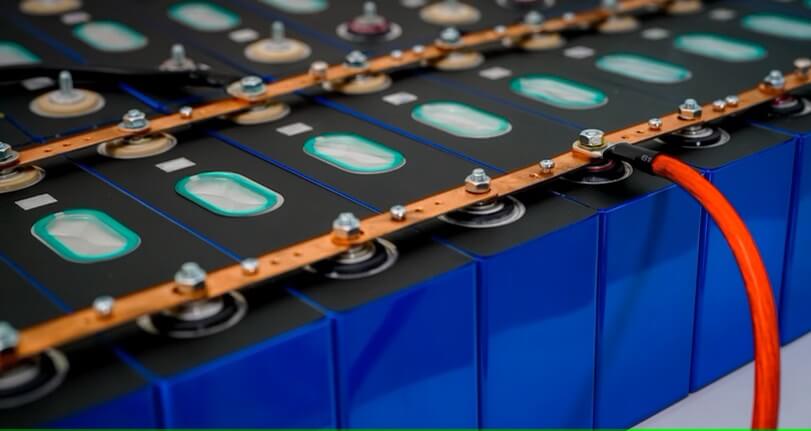As society continues to shift towards sustainable energy solutions, the demand for advanced energy storage technologies has never been greater. Traditional lithium-ion batteries, while widely used, come with limitations such as safety concerns and restricted energy density. Enter solid-state batteries – a promising alternative poised to revolutionize the energy storage landscape.
Solid-state batteries represent a significant departure from conventional lithium-ion batteries in terms of both design and functionality. To grasp their revolutionary nature, it's essential to delve deeper into their structure, operating principles, and unique characteristics.

Solid-state batteries utilize solid electrolytes instead of the liquid electrolytes found in traditional lithium-ion batteries. This fundamental difference eliminates the need for a liquid medium for ion transport, leading to several key advantages. Solid electrolytes are typically made from ceramic, polymer, or glass materials, each offering distinct properties and performance characteristics.
In solid-state batteries, ions (such as lithium ions) travel through the solid electrolyte, enabling the flow of current between the battery's electrodes. This solid-state design enhances safety, stability, and energy density compared to liquid electrolyte-based batteries.
Compared to conventional lithium-ion batteries, solid-state batteries offer several distinguishing features:
1. Enhanced Safety: The absence of flammable liquid electrolytes significantly reduces the risk of thermal runaway and fire, making solid-state batteries inherently safer.
2. Higher Energy Density: Solid-state batteries can achieve higher energy densities, allowing for greater energy storage capacity in the same volume or weight compared to traditional batteries.
3. Improved Stability: Solid electrolytes provide greater chemical stability, reducing the risk of degradation and extending the lifespan of the battery.
4. Flexible Form Factors: Solid-state batteries offer flexibility in design and form factor, enabling the creation of thinner, lighter, and more compact battery packs for various applications.
Solid-state batteries consist of several key components:
1. Solid Electrolyte: The solid electrolyte serves as the medium through which ions travel between the battery's electrodes. Common solid electrolyte materials include ceramics (e.g., lithium garnet), polymers (e.g., polyethylene oxide), and glass (e.g., sulfide-based electrolytes).
2. Anode: The anode, typically made of lithium metal or lithium-containing materials such as lithium metal oxides or lithium alloys, serves as the source of lithium ions during battery discharge.
3. Cathode: The cathode, composed of materials capable of capturing and releasing lithium ions during charge and discharge cycles, completes the electrochemical reactions within the battery.
4. Separator: A separator, usually made of a porous material, prevents direct contact between the anode and cathode while allowing for the transport of lithium ions.
By optimizing the materials and design of these components, researchers aim to maximize the performance, safety, and longevity of solid-state batteries for various applications.

Understanding the intricacies of solid-state batteries provides insight into their potential to transform energy storage technology and drive innovation across industries. As research and development efforts continue, solid-state batteries hold the promise of powering a cleaner, safer, and more sustainable future.
Solid-state batteries offer a host of advantages over traditional lithium-ion batteries, stemming from their unique design and composition. These advantages have the potential to revolutionize energy storage technology and unlock new possibilities across various applications.
One of the most significant advantages of solid-state batteries is their improved safety profile. Traditional lithium-ion batteries rely on flammable liquid electrolytes, which can pose safety risks, particularly under high temperatures or physical damage. In contrast, solid-state batteries utilize non-flammable solid electrolytes, eliminating the risk of electrolyte leakage, thermal runaway, and fire. This inherent safety makes solid-state batteries ideal for applications where safety is paramount, such as electric vehicles, consumer electronics, and grid storage systems.
Solid-state batteries have the potential to achieve higher energy densities compared to traditional lithium-ion batteries. The use of solid electrolytes allows for more efficient packing of active materials within the battery, enabling greater energy storage capacity in the same volume or weight. As a result, solid-state batteries can offer longer-lasting charges and increased range, particularly in applications such as electric vehicles and portable electronics. Higher energy density also contributes to reducing the overall size and weight of battery packs, enhancing their suitability for various applications.
Solid-state batteries exhibit superior performance in extreme temperatures compared to traditional lithium-ion batteries. The solid electrolytes used in solid-state batteries offer greater chemical stability and resistance to degradation, allowing them to maintain optimal performance in both high and low temperature environments. This resilience makes solid-state batteries well-suited for applications where temperature fluctuations are common, such as automotive, aerospace, and outdoor renewable energy systems.
Solid-state batteries hold the potential for faster charging and discharging rates compared to conventional lithium-ion batteries. The unique properties of solid electrolytes, such as higher ionic conductivity and lower resistance to ion transport, enable rapid charging and discharging cycles without compromising battery performance or longevity. Faster charging and discharging rates translate to shorter charging times and improved energy delivery, enhancing the usability and convenience of solid-state battery-powered devices and vehicles.
The combination of these advantages positions solid-state batteries as a game-changer in the field of energy storage, offering safer, more efficient, and more versatile solutions for a wide range of applications. As research and development efforts continue to advance solid-state battery technology, the potential for even greater benefits and innovations looms on the horizon, promising a brighter future powered by solid-state energy storage.
Despite the considerable promise of solid-state batteries, several challenges and limitations must be addressed to realize their full potential and enable widespread adoption. These challenges span technical, economic, and regulatory aspects and require concerted efforts from researchers, manufacturers, and policymakers.
1. Solid Electrolyte Conductivity: While solid electrolytes offer advantages in safety and stability, achieving high ionic conductivity remains a significant challenge. Improving the conductivity of solid electrolytes is crucial for enabling fast charging and discharging rates comparable to or better than traditional lithium-ion batteries.
2. Interfacial Compatibility: Interfaces between solid electrolytes, electrodes, and current collectors can introduce impedance and reduce battery performance. Enhancing the compatibility and stability of these interfaces is essential for optimizing battery efficiency and longevity.
3. Electrode Materials: Developing electrode materials compatible with solid electrolytes is critical for maximizing battery performance and energy density. Research efforts are focused on identifying materials that offer high capacity, stability, and reversible ion insertion/extraction properties.
1. Cost of Production: Solid-state battery manufacturing processes are currently more complex and expensive compared to traditional lithium-ion batteries. Reducing production costs while maintaining quality and reliability is essential for achieving widespread commercialization.
2. Scale-Up Challenges: Scaling up production of solid-state batteries to meet growing demand presents logistical and technical challenges. Establishing large-scale manufacturing facilities and supply chains requires significant investment and infrastructure development.
1. Certification Standards: Solid-state batteries may require new certification standards and testing protocols to ensure safety, performance, and reliability. Developing and implementing these standards in regulatory frameworks can be time-consuming and may delay commercialization efforts.
2. Environmental and Health Regulations: Solid-state battery technologies may involve novel materials and processes with potential environmental and health implications. Compliance with existing regulations and standards, as well as addressing any emerging concerns, is essential for gaining regulatory approval and public acceptance.
1. Consumer Education: Educating consumers and industry stakeholders about the benefits and capabilities of solid-state batteries is crucial for fostering market acceptance and demand. Clear communication regarding safety, performance, and cost-effectiveness is essential for overcoming skepticism and encouraging adoption.
2. Competition from Established Technologies: Solid-state batteries face competition from established lithium-ion battery technologies, which continue to improve in terms of performance and cost. Convincing manufacturers and consumers to transition to solid-state batteries requires demonstrating clear advantages and addressing perceived risks and uncertainties.
Addressing these challenges and limitations will require collaboration and innovation across the industry, academia, and government sectors. Continued research and development efforts, coupled with supportive policies and investments, are essential for overcoming barriers and realizing the transformative potential of solid-state batteries in powering a cleaner, safer, and more sustainable future.
Solid-state batteries hold immense potential to revolutionize various industries and applications, offering a range of benefits over traditional lithium-ion batteries. Understanding these applications and their potential impact is essential for recognizing the transformative role solid-state batteries can play in shaping the future of energy storage and mobility.

1. Electric Vehicles (EVs): Solid-state batteries have garnered significant attention in the electric vehicle market due to their enhanced safety, higher energy density, and potential for faster charging. The adoption of solid-state batteries in EVs could accelerate the transition away from fossil fuels, reduce greenhouse gas emissions, and enhance driving range and performance.
2. Autonomous Vehicles: Solid-state batteries could play a crucial role in the development and deployment of autonomous vehicles. The reliability, durability, and energy density of solid-state batteries are well-suited for powering the advanced sensor systems and computing platforms required for autonomous driving.
1. Smartphones and Tablets: Solid-state batteries offer thinner, lighter, and longer-lasting power sources for smartphones and tablets. The improved safety and energy density of solid-state batteries can enhance the user experience by providing extended battery life and faster charging capabilities.
2. Wearable Devices: Wearable electronics such as smartwatches and fitness trackers require compact, lightweight batteries with high energy density. Solid-state batteries can meet these requirements while offering enhanced safety and reliability, making them ideal power sources for wearable devices.
1. Residential Energy Storage: Solid-state batteries have the potential to revolutionize residential energy storage systems, enabling homeowners to store excess solar or wind energy for use during periods of high demand or when renewable energy generation is low. This can reduce reliance on the grid and increase energy independence.
2. Grid-Level Energy Storage: At the grid level, solid-state batteries can facilitate the integration of renewable energy sources by providing reliable energy storage solutions. By storing excess renewable energy and releasing it during peak demand periods, solid-state batteries can help balance supply and demand on the electrical grid, improve grid stability, and reduce reliance on fossil fuels.
1. Aviation: Solid-state batteries offer lightweight, high-energy-density power sources for aircraft, drones, and spacecraft. The improved safety and reliability of solid-state batteries make them attractive for use in critical aerospace applications, such as powering onboard systems and propulsion systems.
2. Military Applications: The ruggedness, durability, and energy density of solid-state batteries make them well-suited for military applications, including soldier-worn equipment, unmanned vehicles, and communication systems. Solid-state batteries can provide reliable power sources in challenging environments, enhancing mission readiness and effectiveness.
1. Implantable Medical Devices: Solid-state batteries offer compact, long-lasting power sources for implantable medical devices such as pacemakers, defibrillators, and neurostimulators. The improved safety and energy density of solid-state batteries can prolong device lifespan and reduce the need for frequent battery replacements, improving patient outcomes and quality of life.
2. Portable Medical Equipment: Portable medical devices, including diagnostic tools, infusion pumps, and ventilators, require lightweight, reliable power sources for use in clinical settings and remote locations. Solid-state batteries can provide the energy density and performance needed to support these critical medical applications, enhancing patient care and mobility.
The widespread adoption of solid-state batteries has the potential to yield significant environmental and economic benefits:
1. Reduced Greenhouse Gas Emissions: By enabling the transition to electric vehicles and renewable energy sources, solid-state batteries can help reduce greenhouse gas emissions and combat climate change.
2. Energy Independence: Solid-state batteries can enhance energy independence by reducing reliance on fossil fuels and centralized power generation, empowering individuals and communities to generate, store, and manage their own energy.
3. Job Creation and Economic Growth: The growth of industries related to solid-state battery research, manufacturing, and deployment can create new job opportunities and stimulate economic growth in regions investing in clean energy technologies.
Understanding the diverse applications and potential impact of solid-state batteries underscores their importance as a transformative technology with far-reaching implications for energy storage, transportation, and sustainability. As research and development efforts continue to advance, the promise of solid-state batteries in driving innovation and addressing global challenges grows ever more compelling.

Recent advancements in solid-state battery technology have accelerated the pace of innovation and brought the promise of commercialization closer to reality. Leading companies, research institutions, and startups are at the forefront of this endeavor, driving progress and shaping the future of energy storage.
1. Improved Solid Electrolytes: Researchers have made significant strides in developing solid electrolytes with enhanced conductivity, stability, and compatibility with electrode materials. Innovations in ceramic, polymer, and glass electrolytes have contributed to overcoming longstanding barriers to solid-state battery performance.
2. Novel Electrode Materials: Exploration of new electrode materials, including sulfides, oxides, and composites, has led to the discovery of promising candidates with high energy density, reversible ion insertion/extraction properties, and long-term stability. These materials hold the key to unlocking the full potential of solid-state batteries.
3. Interface Engineering: Advances in interface engineering techniques have enabled researchers to optimize the interfaces between solid electrolytes, electrodes, and current collectors, minimizing impedance and improving battery performance. Techniques such as solid-state interphases (SSIs) and surface modification strategies are enhancing the stability and efficiency of solid-state battery systems.
1. Automotive Sector: Major automotive manufacturers, including Toyota, Volkswagen, and BMW, are actively pursuing solid-state battery research and development. Collaborations between automakers and battery suppliers, such as Panasonic, LG Chem, and Samsung SDI, aim to commercialize solid-state battery technology for electric vehicles.
2. Electronics Industry: Leading electronics companies like Apple, Samsung, and Sony are investing in solid-state battery research to power next-generation devices with safer, longer-lasting batteries. Startups such as QuantumScape, Solid Power, and Ionic Materials are attracting attention from investors and industry partners for their innovative approaches to solid-state battery technology.
3. Energy Storage Providers: Companies specializing in energy storage solutions, such as Tesla, AES Energy Storage, and Fluence, are exploring the potential of solid-state batteries for grid-scale energy storage applications. Partnerships between energy storage providers, utilities, and renewable energy developers are driving pilot projects and demonstrations to validate the performance and economics of solid-state battery systems.
1. Government Funding: Governments around the world are investing in solid-state battery research and development through grants, subsidies, and public-private partnerships. Initiatives such as the U.S. Department of Energy's Advanced Research Projects Agency-Energy (ARPA-E) and the European Union's Horizon Europe program provide funding and support for innovative solid-state battery projects.
2. Research Consortia: Collaborative research consortia bring together industry stakeholders, academia, and government agencies to address key challenges in solid-state battery technology. Consortia such as the Solid-State Battery Initiative (SSB) and the Joint Center for Energy Storage Research (JCESR) foster collaboration and knowledge exchange to accelerate progress towards commercialization.
3. Standardization Efforts: Standardization bodies and industry associations are developing standards and guidelines for solid-state battery testing, performance characterization, and safety certification. These efforts aim to establish common protocols and benchmarks to ensure consistency and reliability across the solid-state battery ecosystem.
As the solid-state battery landscape continues to evolve, collaboration and innovation will be essential for overcoming technical challenges, scaling up production, and realizing the full potential of this transformative technology. With concerted efforts from industry players, researchers, and policymakers, solid-state batteries are poised to revolutionize energy storage and usher in a new era of sustainability and innovation.
The future of solid-state batteries holds great promise, with ongoing research, technological advancements, and industry collaborations paving the way for widespread adoption and commercialization. Looking ahead, several key trends and developments are shaping the trajectory of solid-state battery technology and its impact on various industries.
1. Materials Innovation: Research efforts will focus on discovering new materials and optimizing existing ones to improve the performance, safety, and cost-effectiveness of solid-state batteries. Advances in solid electrolytes, electrode materials, and interface engineering will drive breakthroughs in energy density, cycle life, and fast-charging capabilities.
2. Manufacturing Innovation: Innovations in manufacturing processes and equipment will enable the scalable production of solid-state batteries at lower costs and higher efficiencies. Automation, roll-to-roll processing, and additive manufacturing techniques will streamline production and enhance quality control, making solid-state batteries more accessible to mass markets.
1. Electric Vehicles: Solid-state batteries are expected to play a pivotal role in the widespread adoption of electric vehicles, offering improved safety, longer range, and faster charging times compared to conventional lithium-ion batteries. Major automakers are poised to introduce electric vehicles powered by solid-state batteries within the next decade, driving demand and market growth.
2. Consumer Electronics: Solid-state batteries will revolutionize the consumer electronics industry by powering smartphones, laptops, wearables, and other portable devices with safer, longer-lasting batteries. Consumer demand for high-performance, environmentally friendly products will accelerate the adoption of solid-state batteries in the consumer electronics market.
1. Residential Energy Storage: Solid-state batteries will enable homeowners to store excess solar and wind energy for use during peak demand periods or when renewable energy generation is low. Integrated energy management systems and smart grid technologies will optimize energy usage and grid interaction, enhancing energy efficiency and reliability.
2. Grid-Level Energy Storage: Solid-state batteries will play a crucial role in stabilizing the electrical grid and integrating renewable energy sources by providing grid-scale energy storage solutions. Virtual power plants, demand response programs, and energy storage incentives will incentivize the deployment of solid-state battery systems to support grid modernization and decarbonization efforts.
1. Regulatory Frameworks: Governments will develop regulations and standards to ensure the safety, performance, and sustainability of solid-state batteries. Safety testing, recycling requirements, and end-of-life management strategies will be incorporated into regulatory frameworks to mitigate environmental and health risks associated with solid-state battery technologies.
2. Incentive Programs: Governments will implement incentive programs, subsidies, and tax credits to promote the adoption of solid-state batteries and accelerate market growth. R&D funding, manufacturing incentives, and infrastructure investments will support the development and deployment of solid-state battery technologies in key industries and applications.
1. Recycling and Circular Economy: As solid-state battery adoption increases, efforts to develop recycling technologies and closed-loop supply chains will become increasingly important. Recovering valuable materials from end-of-life batteries and minimizing waste generation will support the transition to a circular economy and reduce the environmental footprint of battery production and disposal.
2. Lifecycle Analysis: Lifecycle assessments will evaluate the environmental impacts of solid-state batteries across their entire lifecycle, from raw material extraction to manufacturing, use, and end-of-life management. Transparent reporting and disclosure of environmental metrics will enable stakeholders to make informed decisions and drive continuous improvement in sustainability performance.
In summary, the future outlook for solid-state batteries is bright, with opportunities for innovation, growth, and positive impact across multiple sectors. By addressing technical challenges, accelerating commercialization efforts, and implementing supportive policies and regulations, solid-state batteries will play a central role in advancing sustainable energy storage solutions and shaping the transition to a cleaner, more resilient energy future.
Solid-state batteries represent a transformative leap forward in energy storage technology. With their superior safety, higher energy density, and versatile applications, solid-state batteries have the potential to revolutionize numerous industries and pave the way for a greener, more sustainable future. As research and development efforts continue, the promise of solid-state batteries shines brightly on the horizon, offering hope for a world powered by safer, more efficient, and environmentally friendly energy storage solutions.

扫码关注
We use cookies to understand how our audience uses our site.
Renon Power websites use cookies to deliver and improve the website experience. See our cookie policy for further details on how we use cookies. Privacy Policy